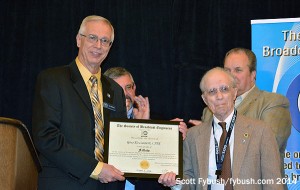NorthEast Radio Watch 12/8/2025: Cichon’s Back in Buffalo
In this week’s issue… Veteran newsman returns - Remembering NY's Leitner, RI's Jones - CT AM saved - Maine AM moves - "Indie" adds suburban signals
In this week’s issue… Big honor for upstate engineer – End of the line for NBC affiliate – Fox, Cox complete Boston swap – iHeart signal swaps granted – More classical in NH – Plus: Hockey on the Radio – The Minor Leagues
*Too often in this column, when we’re singing the praises of one of the industry’s pioneering engineers, we’re doing it in the context of an obituary. So it’s nice to be able to say by way of preface that Gino Ricciardelli is alive and well and still working, well into his 90s.
 After Wednesday’s SBE 22 Expo at Turning Stone in Verona, the veteran Binghamton engineer can now add “Fellow of the Society of Broadcast Engineers” to his list of honors, and what a well-deserved honor it is! A World War II veteran (though his time with “submarines” was strictly with the cable variety, not the vessels, as he noted with a smile), Ricciardelli came back to Binghamton to find himself charged with learning how to build the market’s first TV station, WNBF-TV (Channel 12). After flipping the switch to turn that station on, he went on to build the second station in the market, WINR-TV (Channel 40), as well as its first educational outlet, WSKG-TV (Channel 46).
After Wednesday’s SBE 22 Expo at Turning Stone in Verona, the veteran Binghamton engineer can now add “Fellow of the Society of Broadcast Engineers” to his list of honors, and what a well-deserved honor it is! A World War II veteran (though his time with “submarines” was strictly with the cable variety, not the vessels, as he noted with a smile), Ricciardelli came back to Binghamton to find himself charged with learning how to build the market’s first TV station, WNBF-TV (Channel 12). After flipping the switch to turn that station on, he went on to build the second station in the market, WINR-TV (Channel 40), as well as its first educational outlet, WSKG-TV (Channel 46).
Ricciardelli’s colorful career included many decades with channel 40, now WICZ-TV, and with its parent company Stainless Broadcasting. How many engineers who built the first black-and-white analog stations in the 1940s went on to build out DTV conversions? Gino did, and he’s still a consultant to WICZ and its corporate sisters.
His long history with the SBE goes back almost to the beginning: as member #117, he’s both a life member and a charter member of the national organization and Binghamton’s Chapter 1. And while he doesn’t travel too much anymore, his fellow Chapter 1 members were happy to drive him to Turning Stone to receive a standing ovation at the SBE’s national awards dinner, held as part of the SBE national meeting that was part of this year’s SBE 22 Expo.
Congratulations, Gino!
CLASSIFIED ADS – Place yours today by contacting Lisa!
SITUATION WANTED: Does your small-market station need a solid air talent/operations/social media person? I’m your man. Good pipes and production skills, extensive live and tracked experience, knowledge of multiple automation systems. I’m ready to help your station connect with the communities it serves. E-mail broadcastinglive@radio.fm
[private]
*For a long, long time, Boston was an unusual top-10 market in that it had no network owned-and-operated TV stations. NBC tried to change that in the 1960s with a never-consummated deal to buy WNAC-TV (Channel 7), but it took until the 1980s for MASSACHUSETTS to achieve O&O status, first with Fox’s acquisition of WFXT (Channel 25) and then the CBS purchase of Westinghouse that brought WBZ-TV (Channel 4) into the fold. In the meantime, Fox sold channel 25 to the Celtics, then reacquired it – and now it’s traded WFXT away once again.
 As of last week, WFXT belongs to Cox, which got both Boston and WHBQ-TV (Channel 13) in Memphis from Fox in exchange for the Fox affiliate the network has long coveted, KTVU (Channel 2) Oakland/San Francisco, along with its independent sister KICU (Channel 36). The deal gets Fox out of an AFC market in which most of the Patriots’ games are on CBS’ WBZ-TV and puts it into an NFC market where most 49ers games air on KTVU. It also brings some key KTVU managers east to WFXT: Lee Rosenthal will become WFXT’s news director, joining the GM swap we already knew about that brings Cox’s Tom Raponi to Boston in an even exchange for current WFXT GM Gregg Kelley.
As of last week, WFXT belongs to Cox, which got both Boston and WHBQ-TV (Channel 13) in Memphis from Fox in exchange for the Fox affiliate the network has long coveted, KTVU (Channel 2) Oakland/San Francisco, along with its independent sister KICU (Channel 36). The deal gets Fox out of an AFC market in which most of the Patriots’ games are on CBS’ WBZ-TV and puts it into an NFC market where most 49ers games air on KTVU. It also brings some key KTVU managers east to WFXT: Lee Rosenthal will become WFXT’s news director, joining the GM swap we already knew about that brings Cox’s Tom Raponi to Boston in an even exchange for current WFXT GM Gregg Kelley.
And from the Baseless Speculation Dept.: Cox just went to a bit of trouble to grab the “WFOX-TV” calls for itself, and right now they’re on Cox’s Fox affiliate in Jacksonville, the former WAWS-TV (Channel 30). Could that nifty callsign really be meant for what’s now by far Cox’s biggest Fox outlet in W-land?
*Over at WBZ-TV, staffing cutbacks last week claimed several newsroom jobs, most notably that of veteran reporter Joe Shortsleeve. He’d been with WBZ for 24 years, the sort of long tenure that was once the norm at channel 4. Sera Congi and New Hampshire-based reporter Michael Rosenfield are also out at channel 4.
 *The FCC didn’t take long to approve iHeart Media’s big signal shuffle in eastern New England. The former Clear Channel now has the go-ahead to cut back the signals of WWBB (101.5 Providence, RHODE ISLAND) and recently-acquired WCIB (101.9 Falmouth) so it can take Boston-market WBWL (101.7 Lynn) non-directional.
*The FCC didn’t take long to approve iHeart Media’s big signal shuffle in eastern New England. The former Clear Channel now has the go-ahead to cut back the signals of WWBB (101.5 Providence, RHODE ISLAND) and recently-acquired WCIB (101.9 Falmouth) so it can take Boston-market WBWL (101.7 Lynn) non-directional.
We’ve had a spirited discussion going over at the RadioInsight Community about the merits of the moves, which will reduce WCIB’s power and make it directional and, more dramatically, reduce WWBB all the way from class B down to a directional class A from downtown Providence, all in exchange for what looks on paper to be only a slight increase in coverage for “the Bull.” (In practice, we expect the real benefit for 101.7 will come from a big reduction in the adjacent-channel interference it gets from 101.5 across a big swath of the Boston market.)
*A few weeks ago, we noted that a whole bunch of “Hilltowns” LPFM construction permits in western Massachusetts, all of which appear to be connected to the indefatigable Brian Dodge, all filed for callsigns at the same time – and that some of those calls duplicated full-power stations’ callsigns in the region. Now at least one of those callsigns has been revoked: the 97.9 in Williamsburg (“Citizens for a Better Hilltowns”) had briefly been granted WCCC-LP, but now has no callsign on the books. Did Dodge (or “Tim Allen,” whose name is attached to these applications) tell the FCC he had permission to duplicate that famous Hartford callsign even when he didn’t?
*The Marconi Broadcasting Foundation isn’t having much luck in its attempt to put a new 101.1 LPFM in Cranston, Rhode Island. Its initial application for 101.1 ended up in a big mutually-exclusive group, and its attempt to modify the application to use 94.9 was dismissed last week because it would be third-adjacent to WBRU (95.5 Providence), which is on the FCC’s list of stations with reading services for the blind on their subcarriers. Those stations get enhanced third-adjacent protection. (There’s another interesting issue here for the localized LPFM service: if it had been granted the LPFM it sought in Cranston, Marconi says it would have divested the LPFM license it already owns – WIFL-LP in Wiersdale, Florida.)
Where are they now? The WALE callsign that migrated from Fall River to Providence only to die an ugly death with the now-defunct AM 990 facility has now won a well-deserved Florida retirement. It’s now on “105.5 the Whale” in St. Augustine, Florida, the former Steve Kingston-owned WYRE-FM.
*It’s been a month of departures at CBS Radio in Hartford, CONNECTICUT. On the heels of the retirement of veteran WTIC (1080) sportscaster Scott Gray, the news-talker parted ways last week with Pastor Will Marotti, who’d been doing afternoons since the disgraced former governor John Rowland exited that shift. WTIC says Marotti wasn’t intended to be a permanent replacement for Rowland, and he’ll continue to fill in there. For now, sports guy Joe D’Ambrosio takes the afternoon shift until a permanent host is announced.
Down the hall at WRCH (Lite 100.5), Joe Hann retired from his afternoon shift on Friday, ending a 25-year run with the station and 40 years in the business. No replacement has been named there yet, either.
 There’s a new legal ID coming to southern Connecticut: Connoisseur’s WFOX (95.9) has been granted a city-of-license change from Norwalk to Southport. The station will stay at its current Norwalk transmitter site and Milford studio; becoming a “Southport” station in name only. So why make the move? As best we can figure out, it’s about Nielsen Audio markets: the move will take WFOX out of the Stamford-Norwalk market and into Bridgeport with sister stations WPLR (99.1) and WEZN-FM (99.9).
There’s a new legal ID coming to southern Connecticut: Connoisseur’s WFOX (95.9) has been granted a city-of-license change from Norwalk to Southport. The station will stay at its current Norwalk transmitter site and Milford studio; becoming a “Southport” station in name only. So why make the move? As best we can figure out, it’s about Nielsen Audio markets: the move will take WFOX out of the Stamford-Norwalk market and into Bridgeport with sister stations WPLR (99.1) and WEZN-FM (99.9).
Nearby, WSHU-FM (91.1 Fairfield) is celebrating its 30th anniversary as a public radio outlet with a nifty new website that’s worth a few minutes of your time.
With just hours to go before its construction permit was to expire October 6, Connecticut Public Radio/WNPR put translator W206BW (89.1 Westville) on the air. The 10-watter transmits from West Rock State Park, overlooking Hamden.
*Two new LPFM grants in New Britain have emerged out of what was a knotty MX group: Hispanic American Cultural Council wins a slot on 103.5, its originally-requested frequency, while “La Nueva Radio Restauracion AM 1620 Inc.” gets a grant on 96.9.
*There’s a new format in the Lake Sunapee region of NEW HAMPSHIRE. After acquiring silent WSCS (90.9 New London) from Sawyer-Colby College, Bob Vinikoor’s Vinikoor Family Foundation returned it to the air Thursday as “Classical WSCS,” complete with a new website at ClassicalWSCS.org. WSCS is now the second all-classical signal in the Granite State, joining New Hampshire Public Radio’s WCNH (91.5 Bow) down I-89 in the Concord market.
*In NEW YORK,the latest chapter in the slow-motion disassembly of Robert Pfuntner’s Pembrook Pines group is in the Southern Tier village of Bath, where WVIN (98.3) and WABH (1380) are now in the hands of court-ordered receiver Richard Foreman, who’s charged with selling them to pay off Pfuntner’s creditors. AC-formatted WVIN and sports-talk WABH were almost sold last year as part of a group with Pfuntner’s Elmira stations, but buyer Randy Reid never closed on the sale. The Elmira stations are now awaiting FCC approval for their sale to Gordy Ichikawa’s Tower Broadcasting, and with the recent sale of Pfuntner’s Olean/Salamanca signals to Sound Communications, Pfuntner is now left only with WQRW (93.5 Wellsville) and with WZKZ (101.9 Alfred), which is listed for sale.
There’s a foreclosure sale in the North Country, too, but for different reasons: Essex County says the owners of WNBZ (1240 Saranac Lake) haven’t paid taxes in several years on the station’s studio and tower site at the end of Santanoni Avenue, and so the county seized the properties over the summer. The station paid the back taxes to reclaim the tower site, but wasn’t able to manage the full $35,000 bill to get back the old studio building across the street, so it will be in an auction October 22. WNBZ is still on the air, apparently from the studios of its sister stations in Lake Placid, WIRD (920)/WLPW (105.5).
In Utica, two staffers have departed Townsquare’s WLZW (Lite 98.7) in as many weeks: first Trudy, the station’s longtime midday host, and now Mark Richards has departed the morning slot to make a Townsquare transfer back home to Buffalo, where he’s joining the airstaff at WMSX (Mix 96.1).
In Syracuse, Craig Fox keeps making translator moves; the latest adds a new Oneida-area translator, W279CK (103.7 Durhamville), to the “Dinosaur Radio” oldies network that now includes WNDR (103.9 Mexico), WMBO (1340 Auburn) and three other translator signals. Another of those translators, W251AK (98.1 Nedrow), has been granted a license to cover for a move up the dial to 98.7 from a new site in Camillus, southwest of Syracuse.
Here in Rochester, there’s news on multiple fronts from last year’s LPFM window. New Day Global Mission, one of three MX’d applicants for 97.1/97.3, modified its application for 98.5 instead, and now holds a shiny new CP to operate from the roof of the Strathallan Hotel east of downtown. Rochester Community TV tweaked its application to specify 100.9; it, along with the Ibero-American Action League, now alone on 97.1, are still awaiting FCC action on their applications.
 Meanwhile, Radio Free Rochester’s WRFZ-LP (106.3) is poised to be the first LPFM in town: its antenna went up Saturday on the roof of the Armory on East Main Street, with test transmissions heard for the first time Sunday morning. (Your editor was part of the crew that helped get the WRFZ-LP antenna in the air, and it’s always fun to help build a new signal for the community!)
Meanwhile, Radio Free Rochester’s WRFZ-LP (106.3) is poised to be the first LPFM in town: its antenna went up Saturday on the roof of the Armory on East Main Street, with test transmissions heard for the first time Sunday morning. (Your editor was part of the crew that helped get the WRFZ-LP antenna in the air, and it’s always fun to help build a new signal for the community!)
A local callsign change that slipped by us last month: as of September 19, iHeart’s WQBW (95.1 Honeoye Falls) has become WAIO, playing off its new identity as “Radio 95.1.” The calls don’t get used much on the air, so it’s unlikely there will be confusion between commercial WAIO and another local LPFM due to hit the airwaves soon, WAYO-LP (104.3 Rochester).
Over in Warsaw, WCJW (1140) is now on the air with its daytime power increase, taking “CJ Country” from 2000 watts to 8000 watts outside of critical hours. The increased reach of the AM signal between Buffalo and Rochester allowed for the speedy grant of a power increase at its Batavia translator, W288BZ (105.5), which jumps from 180 to 250 watts.
Heading downstate, Pawling Public Radio has new calls for its new LPFM in Putnam County, which will be WPWL-LP (103.7).
On Long Island, Best Media has lost the license for translator W208AU (89.5 Massapequa). The translator, which was most recently listed as a relay of WSHU-FM (91.1 Fairfield CT), lost its licensed site in 2010 and had apparently been silent since 2012. It failed to respond to an FCC request for information about its operating status in August, and now it’s been deleted.
And on an otherwise quiet week in New York City, we note that Brigitte Quinn has replaced the happily retired Judy DeAngelis in morning drive on WINS (1010).
 *Whenever a newspaper article over the years has claimed that the great state of NEW JERSEY “has no commercial TV network affiliates of its own,” we’ve quietly steamed about the way south Jersey’s WMGM-TV (Channel 40) gets routinely ignored. But sadly, those stories are about to become retroactively accurate: while we already knew that WMGM had sold its license to spectrum speculator LocusPoint and that NBC was pulling its affiliation at year’s end, there’s now word that the scrappy WMGM local news operation will be dismantled and that channel 40 will sign off completely as 2015 dawns. That means LocusPoint is ending the LMA under which former WMGM owner Access.1 continued to operate the station. Its studio facility in Linwood has been listed for sale with a local broker, and whatever plans Access.1 might have had to continue local news over WMGM-LD (Channel 10), which will rimshot Philadelphia when it’s built.
*Whenever a newspaper article over the years has claimed that the great state of NEW JERSEY “has no commercial TV network affiliates of its own,” we’ve quietly steamed about the way south Jersey’s WMGM-TV (Channel 40) gets routinely ignored. But sadly, those stories are about to become retroactively accurate: while we already knew that WMGM had sold its license to spectrum speculator LocusPoint and that NBC was pulling its affiliation at year’s end, there’s now word that the scrappy WMGM local news operation will be dismantled and that channel 40 will sign off completely as 2015 dawns. That means LocusPoint is ending the LMA under which former WMGM owner Access.1 continued to operate the station. Its studio facility in Linwood has been listed for sale with a local broker, and whatever plans Access.1 might have had to continue local news over WMGM-LD (Channel 10), which will rimshot Philadelphia when it’s built.
*Is Cumulus readying a new high-powered translator to add to its station roster in central PENNSYLVANIA? The Harrisburg cluster pioneered HD2-on-translators a few years back with “95.3 the Touch,” and now it appears to be poised to add W243BR (96.5) to its Harrisburg lineup. The translator currently belongs to New Jersey’s Hope Christian Church of Marlton, but it’s applying once again to relocate from York to the site of its primary station, WWKL (93.5 Mechanicsburg), where it would cover most of Harrisburg with 200 watts.
*In Philadelphia, the station-swap contract Beasley and CBS Radio filed last week doesn’t tell us much more that we didn’t already know about the deal that’s sending Beasley’s WXTU (92.5) and WRDW-FM (96.5) to CBS and CBS’ WIP (610) to Beasley. We now know for sure that Beasley will have to change calls on 610, since CBS is keeping the WIP-FM calls on 94.1; we also now know that CBS will lease the current Beasley studios in Bala Cynwyd back to Beasley so that WWDB (860) and WTMR (800 Camden NJ) can stay put, along with whatever 610 becomes. (We’d guess that WXTU will join CBS’ WOGL 98.1 and WPHT 1210 in the former KYW space now being rebuilt for them at 400 Market St. in Center City; as noted last week, the smart money is on 96.5 becoming KYW-FM and operating from the current KYW 1060 studios on Spring Garden Street.)
In Berwick, Family Stations is applying to relocate its translator W212AG from 90.3 to 89.5; it’s been displaced by last year’s sign-on of WFBA (90.5) in nearby Kulpmont. The translator is fed by satellite from Family’s KEAR-FM (88.1) in Sacramento.
Where are they now? It’s been over six years since Ken Anderson moved on from WODE (99.9 Easton) to San Francisco, breaking up the long-running “Ken and Kitty” morning team that had been part of several Lehigh Valley stations. Kitty McVey stayed on for several more years at WODE, but now she’s reuniting with Anderson a long way from the Lehigh Valley. The “Ken and Kitty Morning Show” is now in Memphis, where Anderson and McVey started last week at WEBL (“95.3/97.7 the Rebel”), where their PD is another NERW-land alumna, Nikki Landry, who moved on from WBEE in Rochester to work with Anderson at KBWF in San Francisco.
*It was a “just say no” kind of a week for regulators in CANADA, where the CRTC turned thumbs down on two stations seeking better signals. In Montreal, Radio Moyen Orient wanted a 50-watt nested FM repeater on 104.5 for its CHOU (1450), but the CRTC says the St.-Leonard area where the FM would have been located is outside the main service area of the AM signal, so it’s not an appropriate use for a nested repeater.
In Brighton, Ontario, My Broadcasting wanted more power at CIYM (100.9), where it says 316 watts/155 m isn’t enough to properly serve the downtown core. While the CRTC agreed that CIYM needs more power locally, it says the proposed boost to 2680 watts average/5 kW max DA/146.5 m would have given the station more coverage not just in Brighton but in the adjacent Belleville/Trenton market as well.
 Just south of Belleville, there’s a new local signal testing in Prince Edward County. CJPE (99.3) in Picton plans to make its official launch as “County 99.3” on Wednesday.
Just south of Belleville, there’s a new local signal testing in Prince Edward County. CJPE (99.3) in Picton plans to make its official launch as “County 99.3” on Wednesday.
The CBC wants to combine its signals in Mulgrave, Nova Scotia into a new antenna. CBHB (106.7), the Radio One signal, would go from 93.4 kW/165 m to 40.2 kW average/100 kW max DA/192 m, while CBH-2 (103.1), with Radio Two, would go from 40.5 kW average/100 kW max DA/170 m to 31.9 kW average/81.7 kW max DA/192 m.
*Our Hockey on the Radio coverage continues this week with the minor leagues, including some big moves in the AHL. The Flyers’ top farm team, the Phantoms, left its temporary home in Glens Falls last spring to return to Pennsylvania and a new arena in Allentown, but the Lehigh Valley Phantoms brought announcer Bob Rotruck along with them as they made their move. His play-by-play is now heard on WSAN (1470 Allentown), which is carrying the full season.
Replacing the Phantoms in Glens Falls is the Calgary Flames’ top farm team, formerly the Abbotsford (BC) Heat. The new Adirondack Flames pick up where the Phantoms left off, on WCQL (95.9 Queensbury), and this year they’re also simulcast on sister station WWSC (1450 Glens Falls).
Elsewhere around the AHL, the Portland Pirates (back home after spending last season in Lewiston) call WLOB (1310 Portland) home. Otherwise, it’s all iHeart stations for the league around New England. New Hampshire’s Manchester Monarchs return to WGIR (610) for another season. In Massachusetts, the Worcester Sharks play on WTAG (580/94.9), while the Springfield Falcons are once again on WHYN (560). The Providence Bruins appear to be webcast-only this year, as are the Bridgeport Sound Tigers, while the Hartford Wolf Pack are in the second year of their two-year deal with WPOP (1410).
The Albany Devils play a partial season (38 games) on WTMM (104.5 Mechanicville), with Josh Heller in the booth. The Utica Comets host the AHL All-Star Game in their second season; their games are once again on Galaxy’s WKLL (94.9). Dan D’Uva calls the full season of Syracuse Crunch games on Galaxy’s “ESPN CNY” stations, WTLA (1200)/WSGO (1440 Oswego) and their FM relays on 97.7 and 100.1. Our hometown Rochester Americans remain on WHTK (1280) with the venerable Don Stevens in the booth, and the Binghamton Senators play on iHeart’s WINR (680), aka “Oldies 96.9” via its FM translator.
In addition to the new Lehigh Valley entry in Pennsylvania, the Hershey Bears return to WHP (580), while the Wilkes-Barre/Scranton Penguins move to a new radio home on Entercom’s WILK network (WILK-FM 103.1 Pittston, WILK 980 Wilkes-Barre, WBZU 910 Scranton, WBZN 1300 Hazleton). The baby Pens also have broadcast TV coverage, via WQMY (Channel 53).
North of the border, Matt Holmes calls the Hamilton Bulldogs on CHML (900). In the shadow of the Leafs, the Toronto Marlies don’t have any broadcast radio this year, with a handful of TV games on Rogers TV. Out east, the St. John’s Ice Caps are on CJYQ (930) all season long, with 20 games on Rogers TV.
The East Coast Hockey League has three teams in plausible proximity to the East Coast this year. The Reading Royals play on WIOV (1240/98.5), the Elmira Jackals move from Pfuntner’s WEHH back to Community Broadcasters’ WNGZ (104.9), with Jared Abbott in the booth, and the Brampton Beast move from the CHL to the ECHL without a broadcast radio home.
[/private]

As we announced a few weeks ago, the 2026 edition of the Tower Site Calendar will be the last.
We began publishing it 25 years ago, and the broadcast landscape is radically different now.
Radio World just ran an excellent article about us if you want to know more.
Once it’s gone, that’s it. We won’t be printing any more.
Thank you to everyone who saw our announcement and rushed to buy it. We appreciate you.
(There are some calendars from previous years if you want more of a tower photo fix — all under $5.)
But don’t wait to get this year’s Tower Site Calendar — buy it now!
We are selling the Broadcast Historian’s Calendar again this year, but we have that in an even smaller quantity — definitely don’t hesitate for that.
And visit the Fybush Media Store to check out our selection of books and videos, too!
In this week’s issue… Veteran newsman returns - Remembering NY's Leitner, RI's Jones - CT AM saved - Maine AM moves - "Indie" adds suburban signals
In this week’s issue… Scripps stations face takeover - Sinclair moves more affiliations - CT stations sold - Maine AM surrendered - Remembering WVBR's Shapiro, WABC's Morgan
In this week’s issue… CT TV legend succumbs to cancer - Remembering PA's Adams - FCC still stalled by shutdown - Pittsburgh morning host exits
In this week’s issue… FCC faces reopening challenges - Veteran Boston anchor retires - Morning shift in Toronto - NYC FMs expand reach